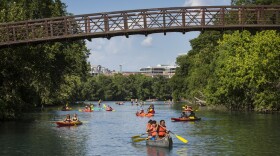A toxic algae bloom at Lady Bird Lake is believed to be responsible for the deaths of a handful of dogs in the last three weeks. The algae, at least initially, cropped up around Red Bud Isle, but it has since spread to other parts of the lake.
What is it and where did it come from?
What's poisoning dogs?
It's not the algae, per se. It's bacteria that glom onto the blue-green algae – what's known as cyanobacteria. The bacterium can come in three forms, all of which are toxic in varying degrees – one form irritates the skin, one effectively shuts down the body by poisoning the liver, and one shuts down the body by severing the connection between the brain and the lungs, causing paralysis and death.
That last toxin is present in the algae on Lady Bird Lake, a neurotoxin called Anatoxin-a. It used to be known by a fittingly grim moniker – "very fast death factor" – because it can kill an organism within an hour if enough of the toxin is ingested.
Where's it coming from?
In a roundabout way, the toxic algae are coming from upstream. Or rather, the nutrients feeding these algae and the bacteria are coming from the Highland Lakes – namely lakes Travis and Austin. The nutrients come from things like agricultural runoff and waste, and they tend to naturally collect around the Mansfield Dam at Lake Travis and the Tom Miller Dam at Lake Austin, says Brent Bellinger, a senior environmental scientist at the Austin Watershed Protection Department.
Last year's flooding – you know, the flooding that caused Austin's water to become so concentrated with sediment the city had to boil water to make it drinkable – didn't help.
"Obviously, we had the large flood event, and there was a lot of sediment that moved through the Highland Lakes ... from the Llano and Pedernales [rivers] and other tributaries," Bellinger says. "So that is a lot of [sediment] that likely had nutrients ... moving into each of the reservoirs and, as they drop out, providing a nutrient source."

That silt eventually settled at the bottom of those reservoirs, allowing for ideal conditions for algae: a low-oxygen area filled with dead plant matter to consume. As the weather gets warmer, those bacteria grow and grow. When the water from those dams is released, there's only one place for it to go: downstream.
How widespread is it?
The city says the toxic algae are fairly concentrated, for now. Red Bud Isle, which has been closed since last week, is the nexus of the blue-green algae, but on Wednesday, officials said the algae had appeared to spread to Auditorium Shores and Barton Creek, downstream from the Barton Springs Pool spillway, also known as Barking Springs.
Bellinger says the Watershed Department is taking samples at sites on Lady Bird Lake two times a week to monitor if the algal growth is spreading. Four of those sites are in Barton Creek, one is at Auditorium Shores, one is at Festival Beach and one is at Red Bud Isle.
What caused it?
Put simply, there's no single cause.
Quay Dortch, the manager for the National Oceanic and Atmospheric Administration's Ecology and Oceanography of Harmful Algal Blooms program, says you can't point to a single factor as the cause; there are a handful of drivers working in tandem.
"These blooms usually occur in water that's high in nutrients and that flow slowly, so that the algae can stay near the surface for a long period of time and get light, because if there's a lot of mixing, then they don't get enough light and they don't bloom," Dortch says. "And then if the temperatures are warm, they tend to grow faster. So, middle of summer is when blooms tend to occur."
But it starts with that runoff from the Highland Lakes. When the sediment settles at the bottom of a lake, an algae bloom's lifecycle begins. They're benthic, meaning they thrive on the dead stuff on the floor, and then float up to the surface as an algae bloom.
From there, the sun fuels the algae, because: photosynthesis.
The more sun there is, the more they'll thrive, says Mark Aubel, a researcher specializing in harmful algae at Greenwater Labs in Florida. Still, while they thrive in the heat, Aubel says it's all relative once the temperature rises.
"You're going to reach a certain point where the heat is what it is and you're going to have stuff blooming. ... We have a situation here where they're going to thrive whether it's 90 degrees or 110 degrees," Aubel says. "In the summertime, you're just going to have more algal blooms because it's warmer than in the winter."
"It's kind of these weird synergies that go on between all these organisms."
Another factor is the lack of rain. The blooms thrive when there's little flow in a body of water, because the bacteria attached to the algae get to stay glommed on to the algae – meaning the neurotoxin stays, too. If there's more flow, the water gets all mixed up, then the algae bloom gets busted up and the cyanobacteria (and the neurotoxin) disperse. The neurotoxin can't survive long on its own and starts breaking down.
Another, more Austin-specific, factor: zebra mussels.
Bellinger says the invasive mollusks purify water, making it clearer. That means more sunlight reaches the sediment at the bottom to feed the algae, which then floats up to the surface.
"It's kind of these weird synergies that go on between all these organisms," he says.
Will this be a problem going forward?
Yes.
All of those weird synergies – and the underlying factors that exacerbate them – aren't necessarily going away.
This is Texas. It's hot. That's not going to stop being a thing. Globally, July was the hottest month on record. Austin averaged 13 triple-digit days last century. This century, so far, we're averaging 38, and by 2036, the heat is expected to get so "off the charts" that climatologists may not be able to measure it.
It's worth pointing out that this time of year is typically the peak season for algae blooms, Bellinger says, but, at least anecdotally, they'll likely become more noticeable.
"I don’t see any reason why this wouldn't become the new norm in this time of year," he said.
As for runoff, well, Austin keeps growing, and, so, the runoff upstream isn't likely to let up. Austin's not alone in that, Aubel says, but he says it's arguably the biggest factor as it relates to these blooms.
"I think it's going to be more due to just the nutrient loads that we as humans are contributing to all of our water bodies that are the main driving force," he said.
What can be done?
Not much for now.
The blooms can be cleared up using chemicals like alum and copper sulfate, but Bellinger says those wouldn't clear up a waterway like Lady Bird Lake because it's so big.
He says the city's not considering either of those chemical treatments, but it has stepped up its monitoring and testing for cyanobacteria. After results come in some time over the weekend or early next week, the Watershed Protection Department and the city will reevaluate its strategy.
The City of Austin urges dog-owners not to take their pets to Lady Bird Lake and advises swimmers to enter the water at their own risk.
Aubel says a dip in temperature will ultimately kill the toxic algae – sooner or later.
"They'll eventually die."
Clarification: A previous version of this story said it was the algae itself that is toxic. It’s actually the bacteria attached to the algae.





